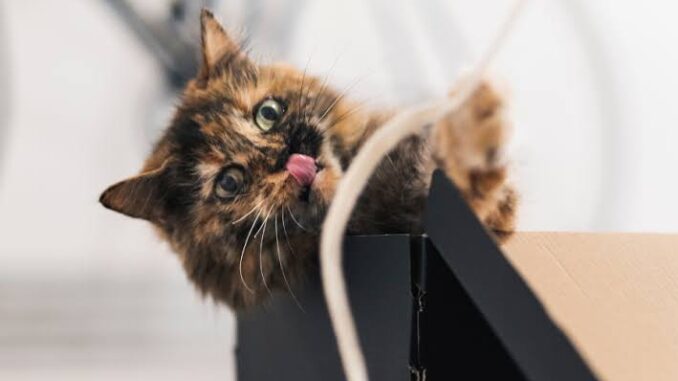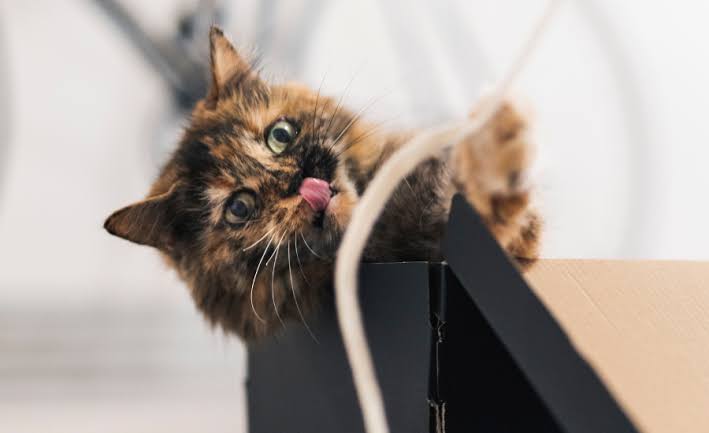
5 Ways to Keep Your Cat Entertained Indoors: Indoor cats live longer, healthier lives, but they can also face boredom without the right stimulation. A bored cat may become lethargic, anxious, or even destructive. Fortunately, indoor enrichment doesn’t have to be complicated. With a bit of creativity and care, you can keep your feline friend both physically active and mentally engaged.

Let’s dive into five highly effective ways to entertain your indoor cat, along with expert tips, real-world ideas.
5 Ways to Keep Your Cat Entertained Indoors
1. Interactive Playtime: Tap Into Their Inner Hunter
Cats are natural predators. Indoors, they don’t get the same opportunity to chase prey—but you can simulate the experience. Interactive play mimics hunting and satisfies both mental and physical stimulation.
Toys That Work Wonders:
- Feather wands and string toys mimic birds and snakes.
- Laser pointers spark instinctive chasing behavior.
- Motorized toys like robotic mice or fluttering butterflies offer self-moving fun.
How to Maximize Play:
- Vary your toys to avoid boredom.
- Let your cat “catch” the toy sometimes (especially with lasers—follow up with a tangible toy they can bite).
- Schedule two 10-15 minute sessions per day.
Bonus Tip:
Incorporate “prey cycles”: sneak (crouch), chase, pounce, and “kill” for realistic satisfaction. End each session with a treat or meal to mimic a successful hunt.
2. Cat Furniture and Climbing Spaces: Create Vertical Real Estate
Cats love to observe their territory from above. Vertical space is critical for environmental enrichment, especially in multi-cat households where hierarchy matters.
Must-Have Climbing Equipment:
- Cat trees/towers with multiple platforms.
- Wall-mounted shelves and cat bridges for high perches.
- Window hammocks or perches with suction cups.
Benefits:
- Increases territory without taking up floor space.
- Offers safe escape zones, especially for shy or senior cats.
- Stimulates curiosity and confidence.
Bonus Tip:
Put a perch near a window with a bird feeder outside. This “Cat TV” can provide hours of entertainment, especially during spring and summer.
3. Food Puzzles and Treat-Dispensing Toys: Feed the Brain
Meal time doesn’t have to be boring. In the wild, cats spend significant time hunting for food. Puzzle feeders recreate this challenge, extending meal time and offering cognitive stimulation.
Examples of Food Puzzles:
- Treat balls that release food as they roll.
- Lick mats for wet food enrichment.
- Slow feeders that turn eating into a problem-solving game.
- DIY ideas like hiding kibble in an empty egg carton or muffin tin.
Benefits:
- Slows down fast eaters, preventing vomiting or bloating.
- Reduces boredom-driven behaviors like meowing or begging.
- Keeps their brain active, especially in older cats.
Bonus Tip:
Rotate between different feeders to keep things fresh. Hide small food portions around the house for a scavenger hunt!
4. Training and Mental Stimulation: Yes, Cats Can Learn Tricks
Contrary to stereotypes, cats are highly trainable with the right approach—usually clicker training and high-value rewards (like tuna or chicken). Mental stimulation is just as important as physical exercise.
What You Can Teach:
- Sit, stay, high-five
- Spin, jump through hoops
- Come when called
- Use a designated scratching post
How to Start:
- Use a clicker or marker word (like “yes!”).
- Reward immediately after the desired behavior.
- Keep sessions short (5–10 minutes) to avoid overstimulation.
Benefits:
- Deepens your bond with your cat.
- Improves communication and confidence.
- Offers mental challenges that beat boredom.
Bonus Tip:
Teach your cat to go into their carrier on cue—it makes vet visits less stressful!
READ ALSO: How to Clean Your Cat’s Litter Box Like a Pro
5. Environmental Enrichment: Keep Their World Stimulating
An enriched environment encourages exploration and curiosity. Regularly rotating toys, adding new textures, sounds, and smells can keep life exciting for your indoor cat.
Ideas for Environmental Enrichment:
- Cardboard boxes of different shapes and sizes.
- Paper bags (handles removed) for crinkly fun.
- Catnip or silvervine toys.
- New scents (like herbs or pet-safe essential oils on a blanket).
- Rotating toys weekly to keep novelty alive.
Sensory Enrichment Tips:
- Use videos or apps made for cats (with mice or fish).
- Turn on classical or nature sounds during the day.
- Introduce pet-safe indoor plants like cat grass.
Bonus Tip:
Set up a “cat zone” with a mix of beds, scratchers, tunnels, and sensory objects. Refresh the space every few weeks.
Why Enrichment Matters
Indoor cats often lack the diversity of stimuli they’d naturally encounter outdoors. Without intentional engagement, they risk developing issues like:
- Obesity
- Depression or lethargy
- Overgrooming or compulsive behaviors
- Aggression or irritability
By implementing these five categories—interactive play, climbing, feeding games, training, and sensory enrichment—you’ll support your cat’s emotional, mental, and physical well-being.
FAQs
How many toys should I give my cat at a time?
Two or three active toys at once is enough. Rotate weekly to maintain interest. Too many toys can become overwhelming or ignored.
How long should I play with my cat each day?
Aim for at least 20–30 minutes of active play, broken into 2–3 sessions. Add more if your cat is high-energy or acting out due to boredom.
Can cats really learn tricks like dogs?
Yes! Cats respond well to positive reinforcement training, especially when paired with treats and short, consistent sessions.
My cat isn’t interested in toys—what can I do?
Try different textures (feathers, crinkle, soft plush), movements (fast vs. slow), or scents (catnip, silvervine). Some cats prefer interactive play with humans over solo toys.
Is it okay to leave my cat alone all day?
Most indoor cats can manage fine alone during work hours if their environment is stimulating. Leave out puzzle feeders, climbing options, and window views.
Are there screen-based games or videos for cats?
Yes! YouTube has cat-specific videos (like birds or mice), and apps like “Game for Cats” let them chase digital critters. Supervise screen time to prevent scratching damage.
How do I enrich a small apartment for a cat?
Use vertical space (shelves, hammocks), rotate toys regularly, and focus on sensory enrichment. Even a window perch with a view can offer hours of stimulation.
How do I know if my cat is bored?
Signs of boredom include:
- Destructive behavior (scratching, chewing)
- Excessive meowing or attention-seeking
- Sleeping too much or lack of curiosity
- Overgrooming or aggression
Is a second cat the best solution for boredom?
Not always. While many cats benefit from a companion, it depends on personality, age, and energy level. Slow introductions and proper matching are essential.
Should I use catnip daily?
Occasional use is best. Some cats can become desensitized if exposed too often. Silvervine and valerian root offer similar effects and variety.
Leave a Reply
You must be logged in to post a comment.